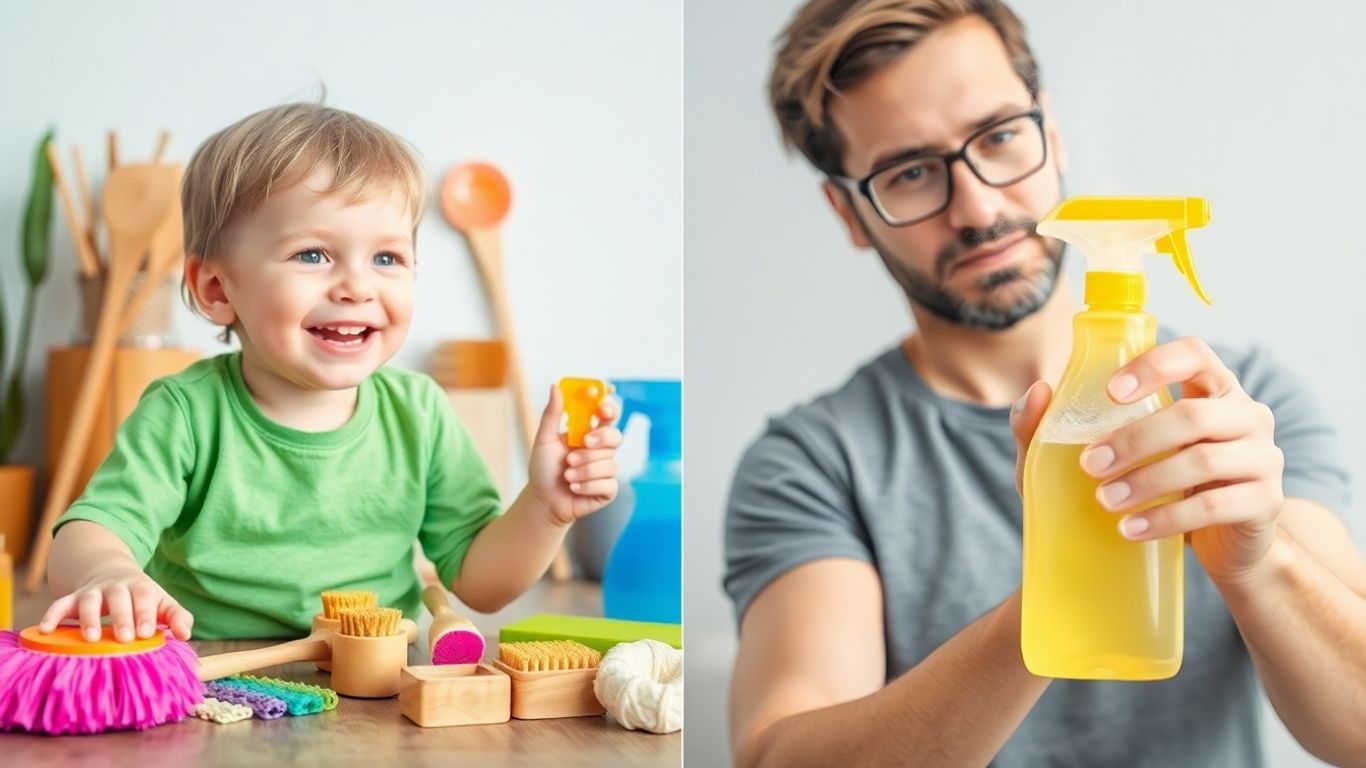When it comes to keeping your home clean, you’ve probably noticed a lot of choices out there. There are the usual cleaners you see everywhere, and then there are the ones labeled ‘eco-friendly.’ It can be a bit confusing figuring out what’s actually best for your family and the planet. Are those green cleaners really as good as they say? Do they actually get the job done? Let’s break down what’s really going on with eco-friendly cleaning products versus the ones we’ve used for years.
Key Takeaways
- Conventional cleaners often contain harsh chemicals like ammonia and bleach, which can cause health issues and harm the environment. Eco-friendly cleaning products use gentler, plant-based ingredients.
- Choosing eco-friendly options can lead to better indoor air quality and reduce skin irritation, making your home a safer space for everyone, including pets.
- Many eco-friendly cleaning products perform just as well as traditional ones, effectively tackling grease and grime using natural power.
- Beyond your home, eco-friendly cleaners often come in sustainable packaging and use biodegradable formulas, which is better for waterways and soil.
- Making the switch is practical; look for certifications, consider concentrated formulas for cost savings, and embrace a routine that benefits your family and the Earth.
Understanding The Ingredients: What’s Inside?
The Chemical Cocktail In Conventional Cleaners
Ever stop to think about what’s actually in those bottles under your sink? Conventional cleaning products often pack a punch with a whole lot of chemicals. These are designed to get the job done fast – think cutting through grease or making surfaces shine. But, and it’s a big ‘but’, many of these ingredients can be pretty harsh. We’re talking about things like ammonia, often found in glass cleaners, and chlorine bleach, a go-to for disinfecting. You might also find phthalates, which are used to make synthetic fragrances smell nice, and Volatile Organic Compounds (VOCs) that can really mess with your indoor air quality. It’s a chemical cocktail that, while effective at cleaning, can come with a side of health concerns.
Gentle Giants: What Makes Eco-Friendly Cleaners Different
So, what’s the alternative? Eco-friendly cleaners are formulated with a different philosophy. They aim to clean your home effectively without relying on those harsh chemicals. Instead, they often turn to nature’s powerhouses. Think plant-based surfactants, which help lift dirt, or natural acids like vinegar and citric acid for tackling tough spots. Many also use essential oils for a pleasant scent, steering clear of synthetic fragrances that can be irritating. The goal here is to be tough on grime but gentle on you, your family, and the planet.
Decoding Labels For A Healthier Home
Reading cleaning product labels can feel like deciphering a secret code sometimes, right? With conventional cleaners, you might not even see a full ingredient list. Regulations in some places don’t require manufacturers to list everything, and when they do, it can be vague. This makes it tough to know exactly what you’re bringing into your home. For eco-friendly options, look for clear ingredient lists. Terms like ‘plant-derived’ or ‘biodegradable’ are good signs, but it’s always smart to do a little digging. Some products might use these terms loosely, so checking for certifications from reputable organizations can give you extra peace of mind.
- Look for certifications: Third-party seals can help verify claims.
- Scan for known irritants: Avoid products with strong artificial fragrances or dyes if you have sensitivities.
- Check for transparency: Brands that openly share their ingredient lists are usually a good sign.
Making informed choices about cleaning products is a simple yet powerful way to create a healthier living space for everyone in your household.
Protecting Your Loved Ones: Health And Safety First
When we think about cleaning our homes, we often focus on how clean things look and smell. But have you ever stopped to think about what’s actually in those cleaning products and how they might be affecting the people and pets who live with you? It’s a big deal, especially for little ones and our furry family members who spend a lot of time close to the floor.
Breathing Easier: Indoor Air Quality Matters
Many conventional cleaners release something called Volatile Organic Compounds, or VOCs. Think of them as tiny chemical particles that easily float into the air. You know that strong, sometimes overwhelming smell you get when you use certain cleaners? That’s often VOCs at work. These can linger in your home long after you’ve finished cleaning, and breathing them in regularly isn’t great for anyone, especially those with asthma or other breathing sensitivities. Switching to eco-friendly options means fewer of these airborne irritants, leading to fresher, cleaner air inside your home.
Gentle On Skin, Tough On Grime
Have you ever experienced dry, irritated skin after a cleaning session? That’s often due to harsh chemicals found in traditional cleaners. These can strip your skin of its natural oils. For babies with delicate skin or anyone prone to eczema, these ingredients can be particularly problematic. Eco-friendly cleaners typically use plant-derived ingredients that are much gentler. They can still tackle dirt and grime effectively without leaving your hands feeling raw or causing skin reactions.
A Safer Haven For Furry Friends And Little Ones
Kids and pets have different interactions with our homes than adults do. They’re often on the floor, touching surfaces with their hands and paws, and sometimes even putting things in their mouths. This means they can be more exposed to any cleaning residues left behind. Conventional cleaners can contain ingredients that are toxic if ingested or can cause irritation. Eco-friendly products are formulated with fewer harsh chemicals, making them a much safer choice for the areas where your children play and your pets roam. It’s about creating a home environment where everyone can be safe and healthy.
Here are a few things to look out for when choosing safer cleaning products:
- Look for certifications: Labels like EPA Safer Choice, Green Seal, or EWG Verified mean the product has met strict standards for health and environmental safety.
- Check the ingredient list: Opt for products with simple, recognizable ingredients like plant-based soaps, vinegar, or essential oils.
- Avoid strong artificial fragrances: These are often a sign of hidden VOCs and can be irritating.
- Consider fragrance-free options: If you or someone in your household is sensitive, fragrance-free is usually the safest bet.
Making small changes in the products you use can have a big impact on the health and well-being of your family. It’s about creating a clean home without compromising on safety.
Do Eco-Friendly Cleaning Products Really Work?
This is probably the biggest question on everyone’s mind, right? You want a clean home, but you’re wondering if those plant-based cleaners can actually tackle tough messes. The short answer is a resounding yes! It’s a common myth that ‘green’ means ‘weak,’ but that’s just not the case anymore. Modern eco-friendly cleaners are formulated with powerful ingredients that get the job done.
Plant-Powered Performance
Think about it: nature has been cleaning itself for millennia. Eco-friendly products tap into that power. They often use ingredients like plant-derived surfactants (which help lift dirt), natural enzymes (great for breaking down stains), and essential oils for scent. These aren’t just fancy names; they’re effective cleaning agents that work hard without the harsh side effects.
Cutting Through Grease and Grime Naturally
So, how do they handle that stubborn kitchen grease or the soap scum in the bathroom? Many eco-friendly cleaners use ingredients like vinegar, baking soda, or citrus-based solvents. These are surprisingly effective at dissolving grease and grime. For instance, the acidity in vinegar can break down mineral deposits, while certain plant-based soaps can lift oils and dirt just as well as their synthetic counterparts. You might be surprised at how quickly a good eco-cleaner can make surfaces sparkle.
Proven Effectiveness for a Sparkling Home
Don’t just take my word for it. Many eco-friendly brands have invested heavily in research and development to prove their products work. Look for certifications from organizations like the EPA’s Safer Choice program or Green Seal. These labels mean the product has been tested and meets high standards for both safety and effectiveness.
Here’s a quick look at what makes them effective:
- Plant-based surfactants: These are the workhorses that grab onto dirt and oil, making them easy to wash away.
- Natural enzymes: Think of these as tiny stain-fighting machines that break down organic matter like food spills or grass stains.
- Acids like vinegar or citric acid: Great for tackling hard water stains and soap scum.
- Alkaline ingredients like baking soda: Excellent for cutting through grease and deodorizing.
The effectiveness of eco-friendly cleaners has come a long way. They are now designed to compete with, and often outperform, conventional cleaners, all while being kinder to your health and the planet.
So, yes, they really do work! Making the switch means you don’t have to compromise on a clean home to keep your family safe and healthy.
Beyond Your Home: Environmental Considerations
When we think about cleaning, it’s easy to just focus on the sparkle in our homes. But what happens after the suds go down the drain? That’s where the real difference between eco-friendly and conventional cleaners shows up.
Reducing Your Footprint With Biodegradable Formulas
Think about what happens to cleaning products after you use them. Conventional cleaners often have ingredients that stick around for a long time, polluting our water and soil. Eco-friendly options, on the other hand, are usually made with biodegradable stuff. This means they break down naturally, much like a fallen leaf in the forest. It’s a big deal because it helps keep our rivers, lakes, and the ground beneath our feet healthier.
- Conventional cleaners can contain chemicals that don’t break down easily.
- Eco-friendly cleaners use ingredients that nature can handle.
- This leads to less pollution in our waterways and soil.
Sustainable Packaging Choices
It’s not just what’s inside the bottle that matters, but the bottle itself! Many conventional cleaning brands still rely heavily on single-use plastic. You know, the kind that piles up in landfills or, worse, ends up in our oceans. Eco-friendly brands are getting smarter about this. You’ll see more companies offering:
- Refillable pouches or concentrate options to cut down on plastic.
- Packaging made from recycled materials.
- Even some brands are experimenting with compostable or truly recyclable materials.
Making the switch to products with better packaging really helps reduce the amount of plastic waste we create.
Caring For Waterways And Soil
So, we’ve touched on this, but it’s worth repeating. The chemicals in conventional cleaners can be pretty harsh. When they get washed away, they can harm aquatic life and mess with the delicate balance of soil ecosystems. Imagine tiny fish or helpful soil microbes getting exposed to things they can’t handle. Eco-friendly cleaners are designed to be much gentler. They aim to clean effectively without leaving behind a trail of environmental damage. Choosing green means choosing a cleaner planet for everyone, now and in the future.
The choices we make in our homes, even down to the cleaning supplies we buy, have a ripple effect. Opting for products that are kind to the environment is a simple yet powerful way to contribute to a healthier world.
Making The Switch: Practical Tips For Families
So, you’re thinking about making the move to eco-friendly cleaning products? That’s awesome! It might seem a little daunting at first, but honestly, it’s easier than you think and totally worth it for your family’s health and the planet. Let’s break down how to make this transition smooth and simple.
Choosing Certified Eco-Friendly Cleaning Products
When you’re in the cleaning aisle, looking for that green label can feel like a treasure hunt. But there are some solid ways to know you’re picking the right stuff. Look for certifications from reputable organizations. These seals mean the product has met specific standards for health and environmental safety. It’s like a stamp of approval that takes the guesswork out of it for you.
- Look for third-party certifications: Programs like EPA’s Safer Choice are a good indicator that a product is made with safer ingredients. You can often find these logos right on the packaging.
- Read the ingredient list (if available): While not always easy to decipher, try to spot familiar, plant-derived ingredients. Avoid products with long lists of unpronounceable chemicals.
- Research brands: A quick online search can tell you a lot about a brand’s commitment to sustainability and ingredient transparency. Many brands are happy to share their philosophy and ingredient sourcing.
Cost-Effective Green Cleaning Solutions
Okay, let’s talk money. Sometimes, eco-friendly products can seem a bit pricier upfront. But here’s the thing: they often go a long way, and there are smart ways to save. Plus, think about the long-term health benefits – that’s priceless, right?
- DIY Cleaners: Seriously, you can make a lot of effective cleaners with stuff you probably already have. Vinegar, baking soda, and lemon juice are cleaning superheroes! A simple glass cleaner can be made with water and vinegar. For scrubbing, baking soda paste works wonders.
- Concentrated Formulas: Many eco-friendly brands offer concentrated versions of their cleaners. You add water at home, which means less packaging and often a lower cost per use. It’s a win-win.
- Refillable Options: Some companies are really stepping up with refill pouches or systems. Buying refills is usually cheaper than buying a whole new bottle each time, and it cuts down on plastic waste significantly.
Embracing A Sustainable Cleaning Routine
Making the switch isn’t just about buying new products; it’s about building habits. Small changes add up to a big impact over time. Think of it as a gentle shift towards a healthier home and a happier planet.
It’s about creating a cleaning routine that aligns with your values, prioritizing safety for your loved ones and minimizing your environmental footprint. Don’t aim for perfection overnight; focus on making gradual, informed choices that feel right for your family.
Here are a few ideas to get you started:
- Start Small: Don’t feel like you have to replace everything at once. Swap out one product at a time, like your all-purpose cleaner or dish soap, and see how you like it.
- Use Less Product: Often, we use more cleaner than we actually need. For most tasks, a little goes a long way, especially with concentrated eco-friendly options.
- Proper Storage: Store your cleaning products (both conventional and eco-friendly) safely, out of reach of children and pets, and in a well-ventilated area. This is important no matter what you use.
- Reusable Tools: Invest in good quality microfiber cloths and reusable sponges. They clean effectively and reduce waste from paper towels. Plus, they’re often more durable than disposable options.
So, What’s the Verdict?
Alright, so we’ve talked about all the ins and outs of eco-friendly versus regular cleaning stuff. Honestly, it seems like making the switch to greener options is a pretty solid move for most families. You’re not just cleaning your house; you’re looking out for your kids, your pets, and even the planet. While some of the fancy eco-brands might seem a bit pricier at first glance, think about it – they often last longer, and you might even save on doctor visits down the road. Plus, knowing you’re not filling your home with harsh fumes or sending yucky chemicals down the drain? That’s got to feel good. So, maybe start small, swap out one or two products, and see how you feel. Your home, and the Earth, will probably thank you.
Frequently Asked Questions
What’s the main difference between regular cleaning stuff and eco-friendly ones?
Regular cleaners often use strong chemicals that can be tough on your health and the planet. Eco-friendly cleaners use gentler, plant-based ingredients that are safer for you, your pets, and the environment. Think of it like choosing a natural remedy over a strong medicine – both can work, but one is much kinder.
Are eco-friendly cleaners really effective at cleaning?
Yes, they really are! Many eco-friendly cleaners use powerful plant-based ingredients that can tackle tough grease and grime just as well as traditional cleaners. You don’t have to sacrifice a clean home to be safe and green.
Can using eco-friendly cleaners improve the air quality in my home?
Absolutely. Many regular cleaners release something called VOCs (volatile organic compounds) into the air, which can cause breathing problems and headaches. Eco-friendly cleaners usually don’t have these harmful chemicals, meaning cleaner air for you to breathe.
Are eco-friendly cleaning products safe for my kids and pets?
Yes, they are generally much safer. Since they use fewer harsh chemicals, they’re less likely to irritate skin or cause issues if little hands or paws come into contact with cleaned surfaces. It’s like choosing a softer towel for sensitive skin.
Do I have to spend a lot more money on eco-friendly cleaning products?
Sometimes the upfront cost might seem a little higher, but often eco-friendly products are concentrated, meaning a little goes a long way and they last longer. Plus, you might save money in the long run by avoiding health problems caused by harsh chemicals.
How can I be sure a cleaning product is truly eco-friendly?
Look for trusted certifications on the label, like EPA Safer Choice or Green Seal. These labels mean the product has been checked and meets high standards for safety and environmental friendliness. It’s like a stamp of approval for being green!





